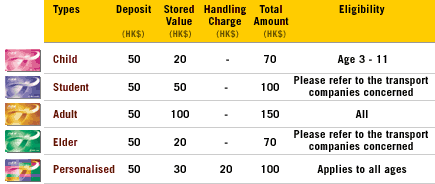Hong Kong
Transportation
Hong Kong is geographically compact and boasts
one of the world's most efficient, safe, affordable and frequent
public transport systems. Whether by taxi, ferry, rail, bus
or tram, you can get around easily and catch wonderful glimpses
of the city along the way.
Hong Kong Internatinal Airport
As the world's fifth busiest international passenger
airport and most active worldwide air cargo operation, Hong
Kong International Airport (HKIA) sees an average of 750 aircraft
take off and land every day. Over 80 airlines, including 18
all cargo carriers, operate at HKIA, linking Hong Kong with
more than 140 locations round the world. An extensive air network
and Hong Kong's strategic location position HKIA as Asia's 'Superhub'
and the most accessible gateway of China. With regular flights
to about 40 destinations in mainland China, HKIA becomes the
airport of choice for international travellers to and from the
Mainland while meeting the ever-growing travel and cargo needs
of the rapidly-expanding Pearl River Delta (PRD) region. In
light of globalization and regional integration, it is crucial
for us to further integrate the extensive international connection
of HKIA with the transport network of PRD airports.
Octopus Cards
- The Easy Way to Travel Most public transport
requires exact change and that's why we recommend that you get
an Octopus
card. This electronic stored-value card is just like money
and is accepted on most public transport including buses, minibuses,
trains, ferries, the Peak Tram, and some taxis. It's even accepted
at convenience stores and fast food restaurants. To pay a fare,
simply place the Octopus card on the reader located next to
the fare box and the fare gets deducted electronically. A new
Octopus card includes a refundable HK$50 deposit. Any leftover
money is also refunded when you return the card. Ask for it
at the Airport Express Customer Service Counters on Level 5
of the Hong Kong International Airport, and the cards are also
available at most public transport customer service centres.

Remark: Special thanks for
Discover
Hong Kong, Hong
Kong SAR Government and Wikipedia
to provide the above information. For further information about
Hong Kong, you are welcomed to visit their websites.
MTR (Metro / Underground / Subway)
The underground MTR
is fast, clean, efficient and inexpensive. Fares range from
HK$4 to HK$26 and can be paid with single-journey tickets or
travel passes like the Octopus card. The MTR is great for getting
to Hong Kong's attractions as well as a host of shopping and
dining outlets.
Bus Bus routes, with
double-decker and single-level buses, cover almost all of Hong
Kong. Final destinations are prominently displayed in English
and Chinese on the front of the bus. Fares are low, usually
ranging from HK$1.20 to HK$45, and are based on distance travelled.
Exact change is required. Octopus cards are accepted.
Minibus Minibuses are
small passenger buses that carry about 16 people. Fares for
minibuses are a little higher than regular buses, but minibuses
are sometimes faster. Please note that minibuses are best suited
for people who can speak some Cantonese and who are familiar
with Hong Kong.
Trains (KCR) The train
(namely KCR) provides commuter
train service from urban areas through the satellite towns and
rural areas to the boundary with Mainland China as well as long-distance
intercity rail transport into Mainland China. It is suitable
for mainland visitors.
Ferry Ferries provide
an essential mode of transport for the outlying islands. In
the inner harbour and the new towns, ferries offer a supplementary
mode of transport to the buses and the railways.
Peak Team Victoria Peak
offers the most amazing vistas of Hong Kong. Getting there can
be equally spectacular. A quick and dramatic way to Hong Kong
Island's highest point, this popular cable railway climbs 373
metres (1,224 feet) in only eight minutes. The fare is HK$20
one way or HK$30 return. Octopus cards are accepted.